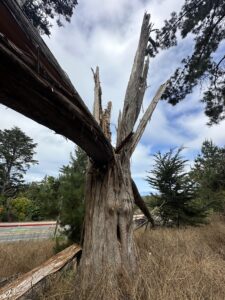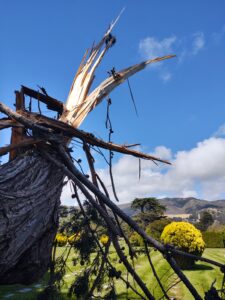
Failing
Forest
Fated
Follows
Form
Found
Felt
Focus
Forensic
Finding
Flowing
Firming
Feeling
Future
Friend
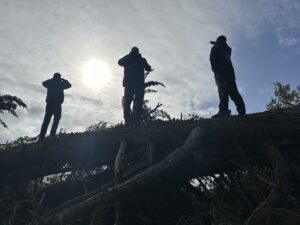
Oh, the storms will come. Again and again, the wind and the rain, the might of winter will bear reckoning. How many branches, how many trees, will fail with the next?
In my seasons of stewardship of the trees of Cypress Lawn, several winters have come and gone, now. So I have witnessed many days of catastrophic failure, with all hands on deck in a state of storm response, at least small branches down from nearly every tree. And then, around that next bend, a century-old trunk smashed to the ground, rootplate upheaved into the sky. A carnage of wonderment.
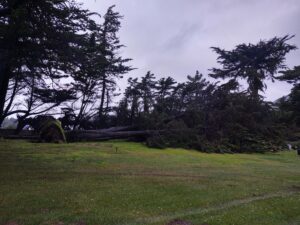
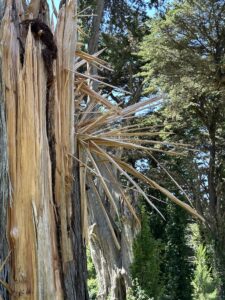
In moments like this, of stormy aftermath – of death – an overarching sentiment of the power of nature is what I’ve known. When a cypress fails by the roots, and crashes to the earth in one, heaving collapse; to witness this is to know humility, to respect that there are forces greater than any human being’s capacity to reckon with.
The way forward, as a manager and steward of these trees, is to surrender to these forces, and find the opportunity in the obstacle, the silver lining to the dark, ominous cloud. There is always one.
In my early days of tending to this place, I remember crying so much with the first few failures. It was a new kind of grief, and an honest sense of my own responsibility, that I could possibly have proactively averted this from happening. Often not the case, in truth, with extensive decay in old specimens combined with a moment of extreme wind speed, following weeks of consistent rain and heavily saturated soils – given the circumstances, these failures are just the simple truth. It happens. Nonetheless, I care deeply, and so felt a profound, genuine loss with each tree, each storm.
 But I learned, in time, to witness each failure as an opportunity to absorb a tree lesson. There is always a reason, a why?, that can be seen through the evidence, broken limbs and all. Tree structure is an organic system of applied physics, and the aftermath of a failure event can be analyzed with a forensic mindset, towards a growing understanding of how trees actually work.
But I learned, in time, to witness each failure as an opportunity to absorb a tree lesson. There is always a reason, a why?, that can be seen through the evidence, broken limbs and all. Tree structure is an organic system of applied physics, and the aftermath of a failure event can be analyzed with a forensic mindset, towards a growing understanding of how trees actually work.
Ever wandering through the ‘metaphorest’, I do believe that this same tenet, of knowledge slowly gained along a pathway strewn with failure and loss, is a journey of the human experience just as much as of the sylvan. From this, I do hold in my own life, as both an arborist and as a man, a philosophy of learning through struggle – even suffering. Beyond our greatest failures stand our most deeply rooted lessons. With a certain beautiful mindset, we shall not lose – we shall learn.
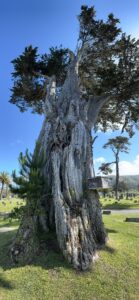
And trees are ever the example of how to be resilient! How to respond to extreme stress, major loss, and grow on with vigor. When I wander through the forest alone, I seek wonder in witnessing the resilience of the wooden ones. They give me many lessons; all I need to do is notice.
There have been enough instances of major Monterey cypress breakages, in particular, during my tenure as Arboretum Director, for me to foster a growing awareness of the typical modes of physical collapse for this gigantic California native plant.
Cypress failures are distinct. They have patterns of loss in light of their genetics, their way of growing. With no latent buds, only new growth from existing green, constant accumulation of endweight at a rate and scale few other species are capable of. Such rapid growth, in snaking and interwoven complexes of branch systems, coming to form a fragile lattice upon the wind.
Time and again, these systems just will fail; it is their very nature. Whether a mid-branch fracture, or a tear-out along the main stem, many hundreds of these classic branch losses have I witnessed.
While the scale of the part (i.e. stem diameter) may result in radically different consequences of failure, the patterns and forms of a 1” and a 1’ branch failure follow a similar shape, a predictable nature – this may be thought of as the cypress way.
This way, these samenesses, so to speak, resonate with me on a life-long journey of learning to read trees, cypresses in particular. For, along this road of witnessing so many afters of these failure moments, I have also been very slowly, subliminally, accumulating a sensitivity to the befores. Cultivating an awareness of what a tree may need, as arborists we may seek to learn the suitable moments of stewardship, how to implement service to lessen the likelihood of there being another aftermath to witness.
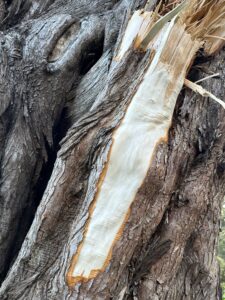 This notion, of growing in our knowing, and so, bit by bit, improving in our conscious capacity to reduce future harm; this course is also a way of personal evolution in the human experience.
This notion, of growing in our knowing, and so, bit by bit, improving in our conscious capacity to reduce future harm; this course is also a way of personal evolution in the human experience.
For one, just to acknowledge our weak points, our tender sensitivities, our human-ness that is vulnerable to being hurt; in a way akin to the wound wrought within a stormy moment, which a tree is prone to suffer from in all of its tree-ness.
The common thread is this – that we are what we are as beings on this earth, and that is OK! We may be aided and nourished, fully, only by an aware source of care, one that notices and acknowledges our needs. In reading trees, and in reading people, failure does not need to be thought of as a fixed, fatal flaw; also, potentially, failure can be held as a friend. A knowing that may help to find a good future in the forest yet to grow. A future, perhaps, worth tending…
